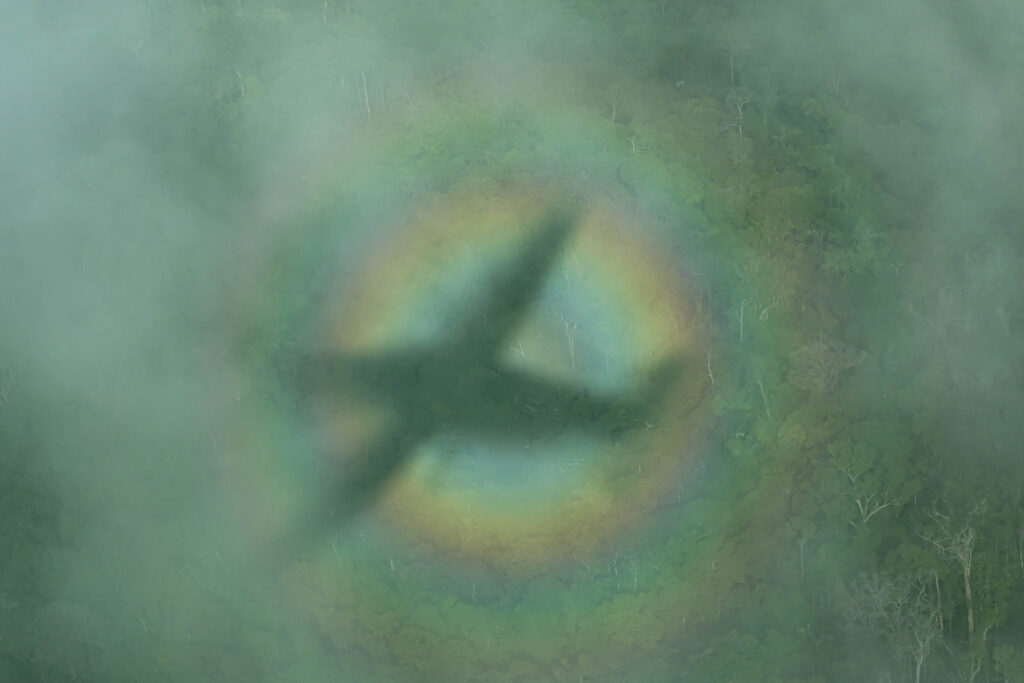Also known by the beautiful nickname “solar glory”, the atmospheric phenomenon anthelion is a spectacular sight for those who´ve been fortunate enough to witness it. Its name coming from the Greek meaning “against the sun”), it’s an optical effect that’s part of the halo family (of which the rainbow is also a member). And in fact, it´s also commonly known in aviation as “aviator’s halo” because it can be seen surrounding the shadow of aircraft.
Dutch astronomer Christoffel van de Hulst (1918-2000) hypothesised that the anthelions can occur in part due to surface waves, and that the coloured rings that can sometimes be seen with the naked eye would arise due to the interference of light rays. deflected by these waves for reasons not yet completely understood.

Of course, for this phenomenon to appear there must be an interaction between the light rays and ice crystals that are present in high clouds such as cirrus, or water droplets present. It occurs thanks to so-called “backscattered light”, which is in turn due to three effects of light: refraction, diffraction, and reflection. Here´s a quick look at each:
Refraction
Some of you may remember this definition from school – and your teacher may even have done a fairly simple experiment to demonstrate it. Basically, it´s the change in a light wave, both in direction and speed, when it passes from one medium to another – for exmple from a gaseous medium to a liquid. For refraction to take place, two things have to happen:
- That these two media have different refractive indexes.
- That the wave affects obliquely on the separation of both media.
So for example if we were to immerse a pencil in a glass of water, it will appear broken when it goes from the gaseous state to the liquid: it is the simplest way to understand what refraction is.
Diffraction
Without going into concepts of physics which would be complex for most of us, we can say that diffraction is the ability of light to “turn corners” when encountering certain obstacles. Or to put a little more scientifically, it´s the deflection of waves (in this case, of light) around the corners of an obstacle or through the opening in the geometric shadow region of the obstacle. Diffraction is described by the Huygens-Fresnel Principle, a method of analysis that studies the propagation of waves.
So how can we observe diffraction in action? If you close a set of blinds on a sunny day, the small holes in the blinds this allow light to pass through, and will project it onto the floor. Those beams of light coming through the blinds are larger than the cracks through which they come in, right? That’s because light spreads around the corners of the obstacle.
Reflection
Back to the example of the pencil, light waves pass through and generate an optical effect that makes the pencil appear broken. But what if the light doesn’t pass through? Then you end up with reflection – which is actually the easiest of these phenomena to understand because it´s the same thing that occurs when you see yourself in a mirror. Essentially, it´s what light does when it comes into contact with a surface that it cannot pass through: it bounces and changes direction.
How Anthelion Influences Flight Conditions
OK, we’ve established that the sun’s rays interacted with small ice crystals or water droplets in the atmosphere. Both the drops (liquid medium) and the crystals (solids) act as prisms, causing the different colours of the solar spectrum to disperse. Depending on the uniformity or not of the water or crystals in dispersion, we will see a luminous halo or something similar to a rainbow.
And yes: beyond how beautiful it may seem, the aviator’s halo is an indicator of certain weather conditions. For example, possible turbulence. So pilots spotting it can make some adjustments to ensure a safe and smooth flight.

